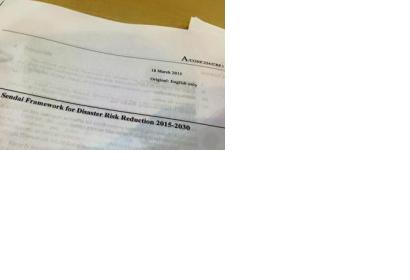After 30 hours of negotiations, the 187 Member States that attended the Third UN World Conference on Disaster Risk Reduction (WCDRR) in Sendai, Japan, agreed in the evening of 18 March (local time) on the post-2015 framework for disaster risk reduction, valid for the period 2015 to 2030. It contains seven targets and four priorities for action. The agreement on the text was announced by Conference President, Ms. Eriko Yamatani, Minister of State for Disaster Management.
Margareta Wahlström, the Secretary-General’s Special Representative for Disaster Risk Reduction and the Head of the UN Office for Disaster Risk Reduction, said: “The adoption of this new framework for disaster risk reduction opens a major new chapter in sustainable development as it outlines clear targets and priorities for action which will lead to a substantial reduction of disaster risk and losses in lives, livelihoods and health.
In the Sendai Declaration, the Heads of State and Government state: "We are strongly committed to the implementation of the new framework as the guide to enhance our efforts for the future. We call all stakeholders to action, aware that the realization of the new framework depends on our unceasing and tireless collective efforts to make the world safer from the risk of disasters in the decades to come for the benefit of the present and future generations."
The importance of Space-based information
As in the previous draft versions, the framework specifically mentions Space-based information. Specifially, under priority area 1: Understanding disaster risk, paragraphs 24 (c) and 24 (f) highlight the importance to "develop, update periodically and disseminate, as appropriate, location-based disaster risk information, including risk maps, to decision makers, the general public and communities at risk to disaster in an appropriate format by using, as applicable, geospatial information technology" and the importance to "promote real-time access to reliable data, make use of space and in situ information, including geographic information systems (GIS), and use information and communications technology innovations to enhance measurement tools and the collection, analysis and dissemination of data" at local and national levels.
With regards to global and regional levels, the document mentions in paragraph 25 (c): "Promote and enhance, through international cooperation, including technology transfer, access to and the sharing and use of non-sensitive data, information, as appropriate, communications and geospatial and space-based technologies and related services. Maintain and strengthen in situ and remotelysensed earth and climate observations. Strengthen the utilization of media, including social media, traditional media, big data and mobile phone networks to support national measures for successful disaster risk communication, as appropriate and in accordance with national laws" and in paragraph 25(g) the importance to "disseminate risk information with the best use of geospatial information technology."
UNOOSA/UN-SPIDER will support the work within the Sendai framework in the coming 15 years and continue to foster a global partnership to steer efforts to promote the use of Space-based information for disaster risk reduction at the national, regional and international levels.
Download the Sendai Framework for Disaster Risk Reduction 2015-2030

